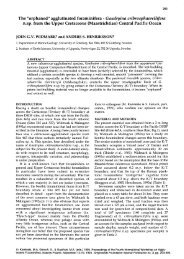Full Text | Download - Grzybowski Foundation - The ...
Full Text | Download - Grzybowski Foundation - The ...
Full Text | Download - Grzybowski Foundation - The ...
You also want an ePaper? Increase the reach of your titles
YUMPU automatically turns print PDFs into web optimized ePapers that Google loves.
Alegret, Ortiz & Kaminski (eds.), 2012. Ninth International Workshop on Agglutinated Foraminifera, Abstract Volume<br />
Species as the basic units in evolution, biodiversity and biostratigraphy<br />
Johann HOHENEGGER<br />
Department of Palaeontology, University of Vienna, A 1090 Wien, Austria<br />
e-mail: johann.hohenegger@univie.ac.at<br />
Many concepts have been developed for the base of taxonomy, the biological species. Still<br />
there is confusion in these concepts between the ‘substance’ of a species, e.g. which factors<br />
makes a species (definition) and how to detect or recognize a species (delimitation). Concepts<br />
like morphospecies and chronospecies (= palaeospecies) that are mainly used for fossil<br />
specimens, and all methods based on molecular genetic methods belong to the group of<br />
concepts for delimitating species.<br />
<strong>The</strong> species can be defined as a pool of contemporarily interconnected genotypes. This<br />
pool can be homogeneous or be divided into geographically separated sub-pools.<br />
Interconnectivity within such pools is given by the potential to transfer complete genomes or<br />
exchange genome parts through asexual or sexual reproduction. A change in genotype<br />
frequencies over successive generations is caused by preferred or restricted genome transfer<br />
due to evolutionary factors.<br />
After establishment of new adaptive zones, evolutionary factors lead to species<br />
differentiation. Depending on number, duration of the onset and the further role of the new<br />
adaptive zones (stable or continuously changing), various methods of speciation – grouped<br />
into split off and split up speciation – can be established. True speciation is characterized by a<br />
complete loss of the potential to transfer genomes between the new species without the<br />
possibility to fuse (hybridise) when their adaptive zones come in contact or overlap. In case of<br />
a broad geographical distribution, the area might be differentiated into several adaptive zones,<br />
where transferability between subgroups is restricted or even lost. Temporarily disconnected<br />
adaptive zones can again become combined, reinstalling transferability between sub-pools of<br />
genotypes. Genotypically and morphologically different subgroups preserving transferability<br />
are thus not species; taxonomically, these structurally distinct subgroups can be treated as<br />
subspecies. Due to this uncertainty in the transition zone, a delimitation of species in the<br />
Recent is difficult in genotypically related but geographically separated groups. This is also<br />
the case in fossil forms when regarding a single geological horizon.<br />
A strong discontinuity in a single evolutionary line is caused when a new adaptive<br />
zone for the species opens contemporaneously with the closing of the previous adaptive zone.<br />
This type of speciation, termed ‘quantum evolution’ or ‘punctuated gradualism’, is a special<br />
form of a geologically instantaneous ‘split off speciation’, where the mother species becomes<br />
extinct.<br />
Contrary to quantum evolution, an instantaneous change in the transformation rate<br />
within an evolutionary line does not lead to new species. <strong>The</strong> clear differentiation in the<br />
species transformation rates should be taxonomically treated as different subspecies.<br />
Because the potential to transfer genomes or genome parts is a non operational<br />
criterion for delimiting species, the main criterion for recognizing species is character’s<br />
homogeneity (including molecular genetic methods). Because molecular genetic methods are<br />
restricted to living organisms, morphological criteria have to be used for recognizing and<br />
delimitating species by the criterion of homogeneity, especially in the fossil record.<br />
Homogeneity (including continuity) has to be checked in the four dimensions ‘shape’,<br />
40



